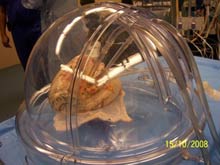Type I diabetes is an autoimmune disease which destroys the beta cells within the pancreas, preventing the organ from producing and excreting insulin. Without insulin, cells within the body cannot absorb sugar and if left untreated, Type I diabetes is fatal.
The researchers at the University of California, Santa Barbara, have developed a device that has a potential to revolutionize the treatment for Type I diabetes. While the device does not cure diabetes, it will make treatment simpler, Dassau said.
The Doyle Group at the UCSB Chemical Engineering Dept.’s system could eventually act as an artificial pancreas, regulating the blood glucose and drastically helping to prevent the disease’s long-term complications. The device contains insulin pumps and blood glucose sensors, which are linked together by a software control mechanism. The sensors feed blood glucose data to the control mechanism every five minutes, providing the software with an accurate blood sugar reading.
The senior investigator behind the treatment said the mechanism will soon be presented to the Food and Drug Administration for clinical trials. According to him, the software can detect unplanned meals and if it decides that insulin is needed, the pumps release a calculated dose from an internal reservoir.

“The control mechanism predicts ahead the insulin within the system and gives the optimal infusion rate,” Dassau said. “This infusion rate is fully automated… no human interaction is required.”
The device, also referred to as an ‘artificial pancreatic beta cell,’ has already been subjected to clinical trials overseas (France particularly). According to Dassau, the previous clinical trials should help the artificial pancreas gain FDA approval.
In France, a human clinical trial of an artificial pancreas is underway. The system is fully automated by combining Medtronic MiniMed's long-term glucose sensor and its implantable insulin pump. A summary of the project shows promise as well as some present limitations:
• The implantable sensor is inserted into a neck vein leading to the heart.
• The sensor is connected, via an electrical-type wire under the skin, to the implantable insulin pump: as blood sugar levels fluctuate, a signal tells the pump how much insulin to deliver.
• The sensor accurately measured glucose in 95% of cases when compared with values obtained by fingersticks.
• The blood glucose levels were maintained in the normal range more than 50% of the time in the patients using the pump connected to the sensor.
• Events of hypoglycemia dropped to less than 5%.
• While implantable insulin pumps work for an average of eight years before they have to be changed, the sensors stop working after an average of nine months,
• The mathematical programs that calculate just how much insulin should be delivered at different parts of the day also need to be refined.
According to Frank Doyle, although the research team studied treatments for both Type I and Type II diabetes the artificial pancreatic device will be exclusively tested on patients suffering from type I diabetes.
Although the artificial pancreas is still in the development stages, the pumps and sensors of the device are currently controlled via laptop, which allows the engineers to easily develop and improve the control software. However, the laptop is currently too large to allow patients to move about efficiently.
“When [the artificial pancreas] becomes a developed product, the control mechanism can be stored inside the pump,” Dassau said. “These are part of the product development stages.”Doyle said that the laptop should be phased out as the development process progresses and will most likely be replaced with a PDA or a phone.
MITHIL CHOKSHI
VTPP 435 – 501
http://www.dailynexus.com/article.php?a=18670
















